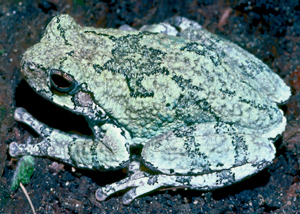This lesson will span both Middle and High School Michigan Standards making connections to wetland ecosystems and natural selection. Students explore gray treefrog morphology and behavior, focusing on how these frogs are adapted to their environment. Students will be asked to describe their preconceptions of what makes a frog. Students will engage in an activity demonstrating what a frog needs to survive in the wild. Students will also examine several species of MI frogs taking notes of their similarities and differences and learning to identify the calls of MI frogs. Finally, students will also play a card game simulating the pros and cons of different reproductive strategies.
At the conclusion of the lesson, students will be able to:
- Identify food chains and food webs in a wetland incorporating the Michigan gray treefrogs
- Understand how the environment and human activity can influence populations.
- Understand that all plants and animals have a definite life cycle, and adaptations to accomplish specific life functions.
- Understand that inherited traits can be influenced by changes in the environment and by genetics
- Understand that characteristics of mature animals may be inherited or acquired and that only inherited traits are passed on to their young.
- Understand that there are different strategies that can be used to try to maximize reproduction
Resources:
- Lesson Plan
- Frog survival game instructions
- Life history gambling game instructions
- Sounds of selection pretest/post-test
- Sounds of selection powerpoint
Lesson plan created by GK-12 Fellow Mike Kuczynski & teacher Marty Green, 2011

